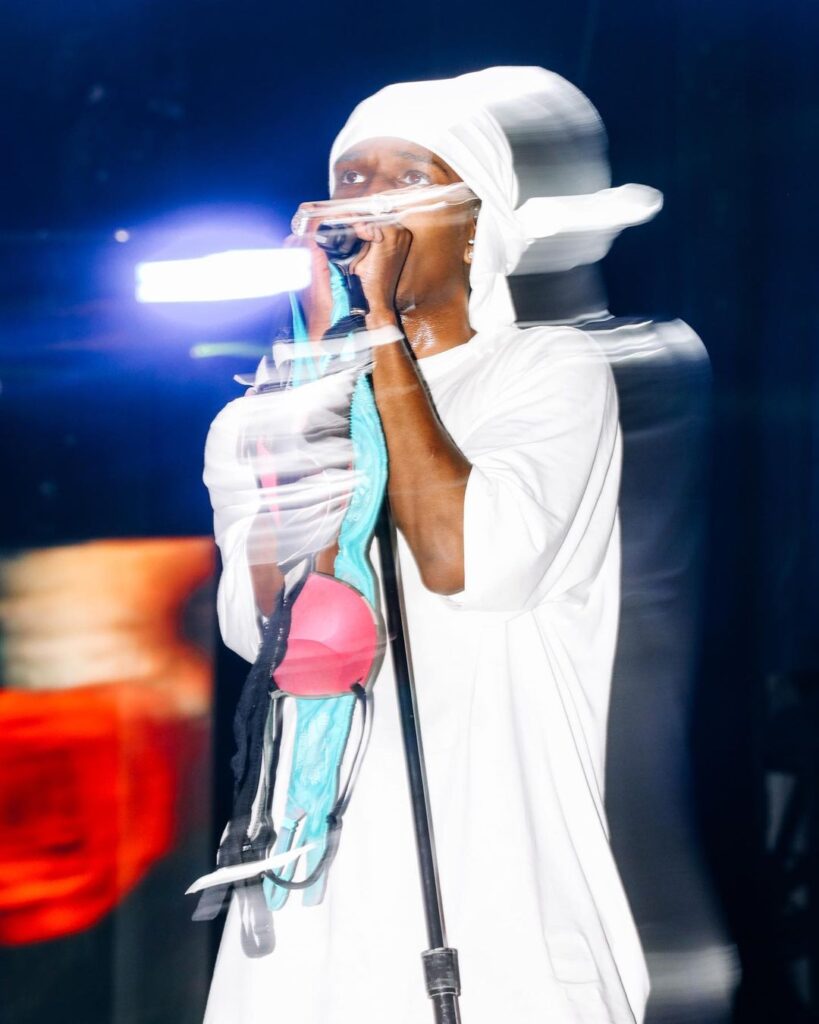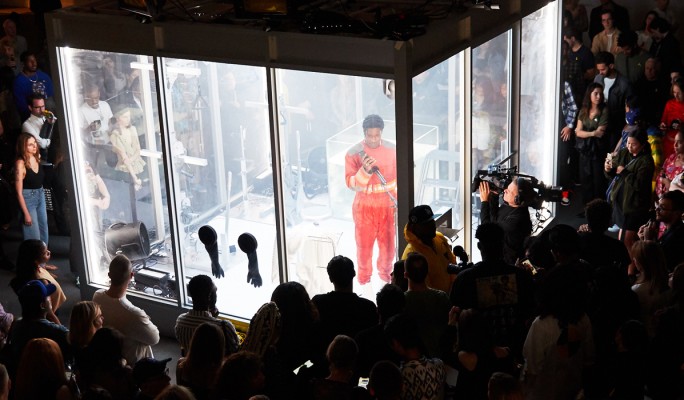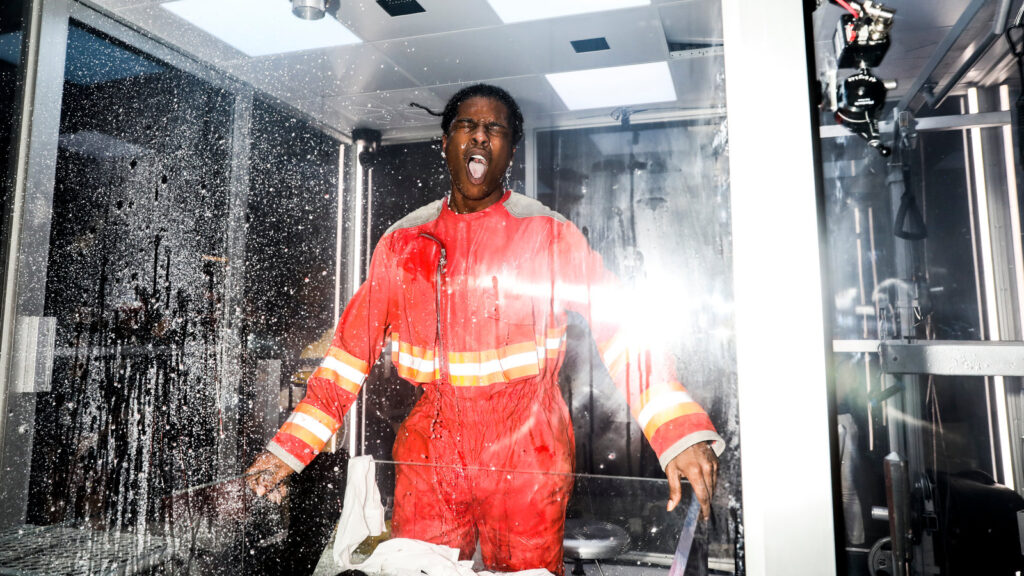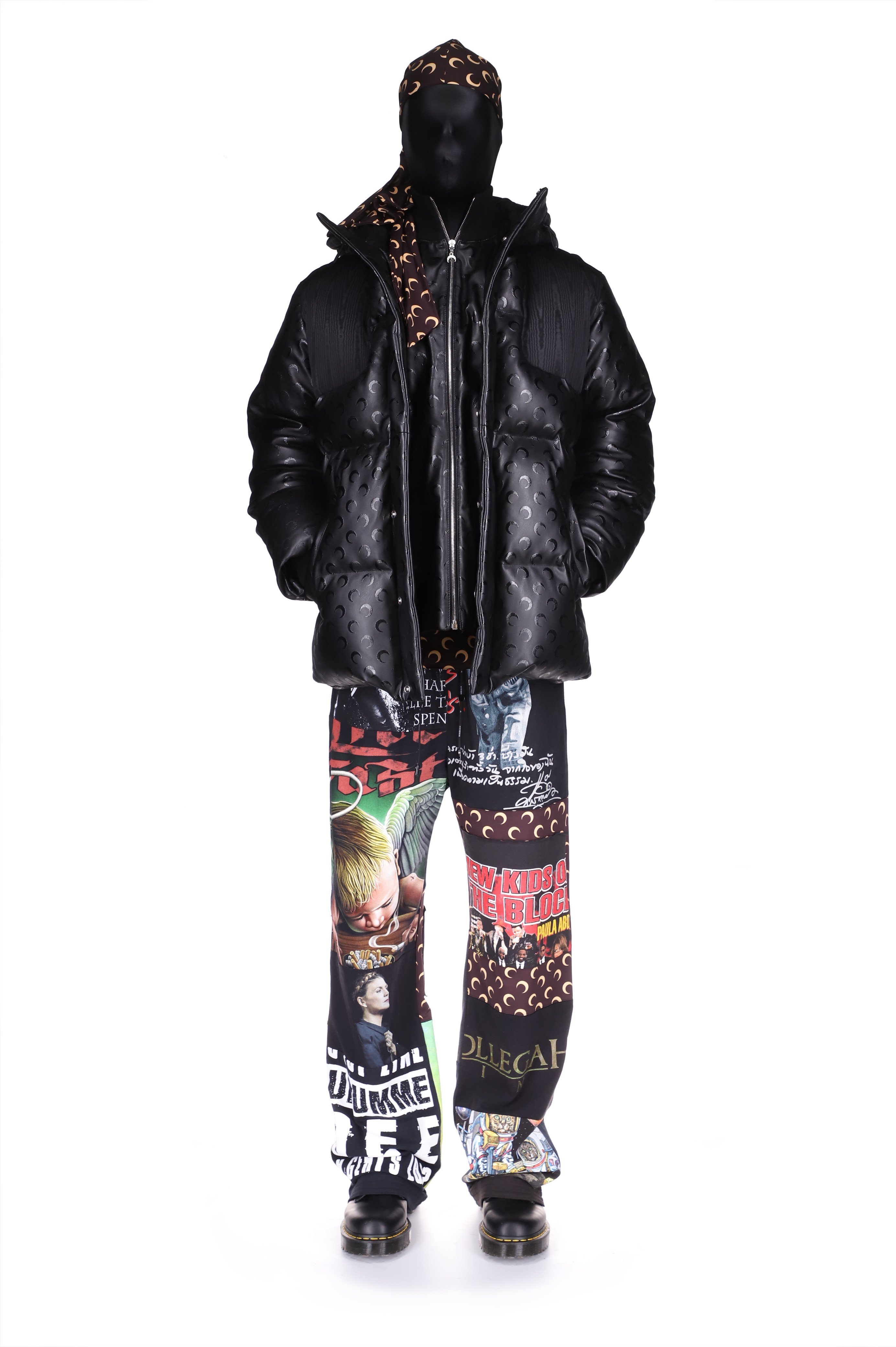🌐 🌐 🌐

The Crippling Attention Span of A$AP Rocky
A$AP Rocky is someone who basks in sudden bursts of inspiration, whooping wild-eyed like a lunchroom bully with a pack of reverent followers present to egg him on. Yes, it’s a curious, childlike intuition necessary for authenticity in arts industries en masse – but in his case, when he finally gets to any point of fully realizing a final product, he is often having far too much fun to follow all the way through.
SAMUEL HYLAND
One afternoon in May of 2018, A$AP Rocky sat encased in a Plexiglass box on the fourth floor of Sotheby’s – a British-founded American multinational art corporation headquartered in New York City – while a sea of sullen, monotonously-dressed press members looked on in confused intrigue. Over the hour and thirty-three minutes that ensued, the rapper was doused in gallons of milk, interrogated, submersed in body-length containers of freezing water, force-fed by attractive women in medical garb, and poked by onlookers through holes in the structure. He donned a high-visibility, orange jumpsuit given to him by Calvin Klein. The stunt was an intricately programmed performance art piece dubbed “Lab Rat,” curated as part of an ongoing collaboration with the hosting institution, and broadcast live on Youtube to thousands of viewers. Moreover, and perhaps even more significantly, it was the final piece of promotion put forth for TESTING, the long-awaited third studio album he was slated to release five days after the event.
TESTING, he often asserted via interviews and social media alike, was a concept record rooted in experimentation; it was his debut expedition into sonic territory uncharted by not only him, but a majority of those who also bore his gritty, East-Coast hip-hop ethos. In one clip from AWGE DVD Volume 3 – just one installation in a series of impressively-edited montage videos put out by Rocky’s multifaceted creative network – he sat on a toilet bowl, months removed from the album’s release, slapping a woman’s buttocks while boasting about his expensive pants. “I’m letting y’all niggas know something right now – catch my Needles by the way, you know what I mean – I’m letting y’all niggas know something right now: I’m shitting on y’all niggas the whole rest of the 2018,” he said through a comedic deep-voice filter, as an often-teased but never-released snippet hammered away in the background. “I’ve been testing a lot of sounds, I’ve been testing a lot of Prada, I’ve been testing a lot of shit, you feel me? So get with me, nigga.”
“One day, the patience will wear thin – and not very long after that, it will run out for good.”
With his third LP, evidenced by both the swank high art reputation he sought during its rollout, and the more toned-down, eclectic musical makeup that defined its output, A$AP Rocky wanted to assert himself as a supreme hyphenate – someone who had graduated from Nike to Balenciaga, Forever 21 to Sotheby’s, rapper to entrepreneur. Most important of all labels, however, he wanted to be regarded by the masses as a guinea pig – and not merely his own guinea pig, but a communal one for all who sought to emulate his experimentation. TESTING’s rollout was rife with social media previews of songs that never saw the light of day, pervasive imagery of crash test dummies, and multi-layered opacity that starkly contradicted with his longtime release-driven translucence. This A$AP Rocky was different from the ones bright-eyed hip-hop heads took a liking to in the early 2010s: whereas then, he was revered for a legendary onslaught of underground loosies and mixtapes that never seemed to stop coming, his once-surefire rootedness in rap music was replaced by question marks, calculated symbolism, milk-drenched interrogations in Plexiglass prison cells.
For the first time in his career, his intentions were neither clear nor predictable. Longtime followers suddenly didn’t know what he was getting at – and so, in a reaction most often afforded to sacred figures like Kanye West and Kendrick Lamar, they began scrambling to fill in the blanks. A$AP Rocky liked this. He leaned into the hysteria, fueling speculation with uncharacteristically cryptic Instagram posts, mantras, and multimedia productions. When I was a high school sophomore and wanted to come off as cool and mysterious, I remember mindlessly visiting his Instagram profile and liking every single perplexing post – it felt gratifying to convince myself that I knew exactly what it all meant, even though my real level of understanding sat somewhere at the complete opposite. Even in my plight, the dynamic was one that A$AP Rocky relished, in which he was now making music for constituents to his game rather than co-conspirators – an elaborate experiment that saw him offer himself up for public tampering with, all the while usurping the very same public’s relatability to him in silence.
“People are scared to test new sounds, so they go with what’s current ’cause it’s the easy thing to do,” he told GQ editor-in-chief Will Welch in 2018. “The top 100 songs sound a certain way. People cater more to that because it’s a bigger demographic behind that, or it’s a guaranteed demographic behind that. I prefer to experiment and have my crowd grow with me and to reach new crowds. I don’t just rap—I actually make music. That’s why it takes time.”

That sentiment – I don’t just rap—I actually make music – encased much more than just the up-front musical frontier it boasted. The idea was one he had become irreversibly obsessed with, a creativity-masked elitism that pushed his past away en route to an uncertain future basked in heightened self-worth (or, as he would dub it in another GQ interview three years later, “elevated taste value”). A$AP Rocky didn’t want you to think he was a rapper – no – he was a musician. A$AP Rocky didn’t want you to think he was simply fielding multiple advertising campaigns at once – no – he was an entrepreneur. A$AP Rocky didn’t want you to think this was all a publicity stunt – no – he had been a genius this entire time.
The “it takes time” alluded to by the Harlem MC was in reference to a three-year wait period in which devoted fans, accustomed to shorter turnarounds, grew impatient. When, after a long, winding period of theatrics, stunts, and teasers, the album was released on May 25, 2018, it received mixed reactions. In a Highsnobiety compilation of social media opinions garnered on its opening night, sentiments ranged from “Thank you (A$AP Rocky) for the fire ass album,” to “(A$AP Rocky) really took 3 years to make this trash album.” In a critical 6.9 Pitchfork review, the music on TESTING was described as “a lack of direction at best and yet more taste-signalling at worst.”
“-I put out my album and I felt like the masses didn’t get it at the start,” he told GQ’s Samuel Hine backstage at one post-release tour stop. “I kind of forgot that’s the same thing that happened with my album prior: I put it out, people fucked with it, and then throughout time people are (like), “Oh my god, this is a masterpiece.” And I guess initially, I was like, Man, did my crowd, did my cult following forget how to mosh? How to slam dance, how to fucking crowd surf, how to go all out?”
The rap world has become gradually and increasingly infatuated with high art, whether that be in the big-money fashion collaborations of Kanye West, the posh gallery entrepreneurship of Jay Z, or the refined visual intuition of Kilo Kish. In seeking to both emulate, and infiltrate, the artistic stature of such a pantheon – the aforementioned Pitchfork review also called TESTING his “attempt to remake Frank Ocean’s insular 2016 album Blonde” – A$AP Rocky lost sight of his own ethos, rushing into an impulsive new vision in such a way that his inexperience was allowed to glare through the cracks. This is, yet, both the superpower and the problem with A$AP Rocky – his attention span is far too short for him to have taken any other course of action. A$AP Rocky is someone who basks in sudden bursts of inspiration, whooping wild-eyed like a lunchroom bully with a pack of reverent followers present to egg him on. Yes, it’s a curious, childlike intuition necessary for authenticity in arts industries en masse – but in his case, when he finally gets to any point of fully realizing a final product, he is often having far too much fun to follow all the way through.
The TESTING era, for instance, saw him push forth an entirely self-created universe, complete with crash test dummy motifs, a gripping visual aesthetic, and a newfound cryptic code-of-conduct that operated as a secret language of sorts for those who either understood, or wanted to pretend that they did. The album as a standalone entity, on the other hand, paled in comparison to the massive ethos it constructed for itself: grand buildups crumbled into miniscule music; impressive multimedia gave way to lackluster production; it began to look less like we were experimenting with him, and more like he was experimenting with us.
When someone like Kanye West releases a new shoe line, no matter how ugly, bulky, or conventionally unattractive the product is, after about one week of Twitter insults, it’s flying off shelves – not because the shoes are nice, but because West has a long enough attention span to see it to its end. There’s a seldom-admitted trust that is cultivated by such diligence, where one can even announce a random bid for President of the United States in July (as, of course, Mr. West did) and be taken as a legitimate spoiler candidate by November. Our adherence to figures like Kanye West is rooted in a consistent reputation of following through on one’s own ideas to a point where the public has no other option but to do the same; when Sheck Wes declared for the 2020 NBA Draft, it was somewhat detectable that the stunt would precede a new creative body of work (which it did), while if Kanye were to declare for an NBA Draft, it would be the subject of ESPN morning television programming for weeks to come. With A$AP Rocky, it becomes hard for anyone to fully commit oneself to an endeavor of his, because you can never be sure whether he’s serious, or he’s just going through another fleeting phase. Think of it like the ABC series ‘Shark Tank’: it’s difficult to invest in a product that, although it may boast excellent marketing, promises zero guaranteed returns. And for that reason, many people are out.

As of right now, A$AP Rocky is in the middle of rolling out his upcoming fourth studio album, All Smiles. Two days ago, he headlined Lyrical Lemonade’s annual Summer Smash festival in Chicago, Illinois, where – just as he did with TESTING – he reveled in the highs of playing unreleased music for audience members who desperately whipped out cell phones and recording devices. “I want to get on some more trippy shit,” he said into a microphone at one point, after performing a yet-to-be-released demo previewed in an earlier digital-only Weedmaps production from April. “Some unreleased trippy shit, one time.”
One such song was the full version of a raucous, three-minute warble that also soundtracked a recent Pacsun advertisement of his curation. A$AP Rocky urged the crowd to “open that fucking mosh pit up,” jumping across the stage area alongside equally headscarf-clad compadres who also yelled into microphones, while fans in the rear section seemed to grow bored.
The song was a familiar one, in that it is the unofficial theme music for Rocky’s ongoing stint as creative director of Pacsun – a gig through which he has already released three A$AP-branded custom Vans slip-ons, and a collection of effervescently-colored streetwear pieces. It comes as part of a burst of hyperactive fashion-adjacent activity the rapper springboarded after a pivotal incident in Sweden two years ago: walking with friends and collaborators in an urban neighborhood of the country as part of his Injured Generation tour, he was followed by a pair of locals who were adamant that he had broken their headphones, and wanted him to pay for the damages. When, after a tense escalation that concluded with Rocky throwing one of his accusers to the ground and pummeling him, he was jailed in a Swedish facility, it became a large issue in American politics. Then-President Donald Trump publicly made it a point to get him home by any means necessary – a move that was thought by many to be a scheme for more support from the black community (“It was a Rocky week,” Trump tweeted upon his return home, “get home ASAP, A$AP!”) – while the rapper himself devoted his time behind bars to introspection. It was during this period that he began obsessively drafting sketches for a dream collaboration with the high-end French fashion conglomerate Marine Serre.
“Because of his track record of miniscule resolve, yet, no amount of high fashion hyperactivity can seem to sway the public into appreciating his output just as much for textiles as for music – it could all be gone tomorrow, and we’re not even sure if he’s thinking long-term about it himself.”
The official fruit of the connection came in the form of an AWGE x Marine Serre capsule released in December of 2020, heralded by a quickly-deleted Instagram post in which Rocky rapped a woozy series of brags about his fashion sense, captioned “GRIM FREESTYLE SNIPPIT X MARINE SERRE.” The outburst was a rare spark of sudden activity that would get the ball rolling for hype around his next project, followed by further teasers in virtual events, performances, and outings.
During all this musical dialogue, however, his most vivacious outlet remained fashion. “He describes his style as completely innate, more like an instinct than a set of well-developed aesthetic values,” Hine wrote of his beginnings in the industry this past July. “But as he grew older and life got a little rougher, he found that immersing himself into the worlds of luxury fashion and streetwear presented a powerful form of escapism.”
This escapism is one that was foreshadowed by a harsh upbringing, throughout which he moved several times to accommodate his oft-incarcerated father on a drug hustle, was imprisoned at the notoriously violent Rikers Island complex for attempted murder at 16 years of age, and was surrounded by criminal activity of varying levels in the slums of Harlem. Gravitating towards high art, and high fashion, meant learning that there was more to having a career than remaining on its launchpad; and so, when Rocky developed a taste for haute worlds unheard of by products of his environment, he tested the waters, then completely submerged himself. What started as a form of escape evolved into a primary obsession.

But gravitating towards this lifestyle also meant appearing to not simply explore beyond, but outright subvert, the rap culture from which he emerged. In one 2019 DJBooth ranking of the 15 Most Disappointing Legacies In Rap and Their NBA Counterparts, A$AP Rocky was ranked fifth. (If you’re wondering who his NBA counterpart was, it was Grant Hill). “Granted, A$AP Rocky doesn’t have a legitimate excuse for failing to live up to his potential. But Rocky, like Hill, was the full package: while Drake was the sensitive rapper and Kendrick tapped into the lyrical niche, Rocky touched both sides and operated as the medium,” his section read. “He could’ve been the Jigga of his generation. Instead, A$AP (Rocky) is more comparable to Kanye: a rapper who latched onto his next hobby (Fashion) en route to forgetting his true potential.”
For what A$AP Rocky has lacked in musical output, he has delivered, even more so, in high-end clothing: endeavors of his spanning from the TESTING era to present day range from ambitious collections with brands like Guess, Dior, and Calvin Klein, surplus creative directorships, and ubiquity as a consultant for entities seeking modern appeal. Because of his track record of miniscule resolve, yet, no amount of high fashion hyperactivity can seem to sway the public into appreciating his output just as much for textiles as for music – it could all be gone tomorrow, and we’re not even sure if he’s thinking long-term about it himself. In the case of someone like Kanye West, oppositely, there is much more leeway granted because of a surefire history that already exists. Kanye West embodied DJBooth’s grievances about Rocky to a level that was arguably exponentially more severe: he would step away from music for years at a time, honing in on grandiose projects in upper-class art while building relationships with adjacent figures like Virgil Abloh. Still, though, as of today, despite his extensive forays beyond musical output, he remains regarded as a genius, while A$AP Rocky is disregarded for similar activity. Even right now, as he curates a maddening rollout for his upcoming tenth studio album DONDA, followers are holding out the same level of obsessive hope that they did in July, when the album’s first of several unsuccessful release dates was announced. The difference between Kanye West and A$AP Rocky that allows something like this to take place is that the former doesn’t care about the audience as much as he does himself, while the latter cares more about feeling like eyes are on him – that is, for however long he chooses to toy with them before he gets bored.
“-whether he is aware of it or not, he is creating for a species of fandom that will cease to exist sooner than he can flesh out another momentary impulse.”
With All Smiles allegedly due out later this year, and a girlfriend by the name of Rihanna, A$AP Rocky once again finds himself in a position where the attention of America is gradually easing back onto him – this time, not for international brush-ups turned diplomatic crises, but for what he has to offer to the cultural climate. In many ways, his legacy is on the line. In an era where overzealous digitization makes public patience wear thinner and thinner with every fleeting viral earworm or dance, the brand of long-game endurance his yield has grown to require is slowly slipping into obsoletion; whether he is aware of it or not, he is creating for a species of fandom that will cease to exist sooner than he can flesh out another momentary impulse. One day, the patience will wear thin – and not very long after that, it will run out for good.
A$AP Rocky built his early reputation on the rock of brash, raucous uphill energy, an A$AP Mob-assisted coup d’etat that stuck a middle finger in the faces of the old school pantheon occupying its path. Now, it seems as if we’re getting closer to a time where Rocky himself will be the declining old school pantheon, fighting for respect – not even relevance – amidst a slew of younger acts who have forgotten about him. He has become dangerously comfortable in his temporary stature: a place where he can appreciate feeling appreciated, while he forgoes the follow-through necessary for the legacy his ethos demands.
